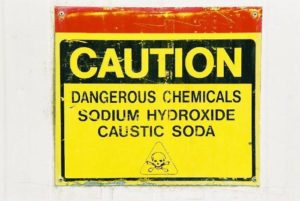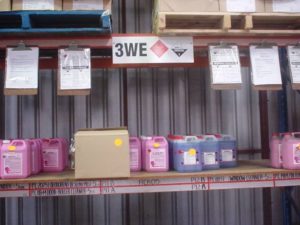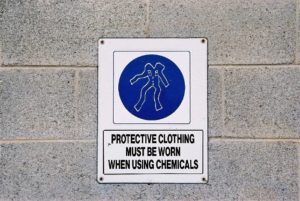Eliminating or reducing hazards associated with exposure to hazardous chemicals
What is a hazardous chemical?
Hazardous chemicals are substances that may harm people, property and the environment. They may affect a worker’s health causing illness, disease or injury.
They include many common industrial, commercial, pharmaceutical, agricultural and domestic chemicals. Examples of hazardous chemicals in meat processing plants include cleaning agents, sanitisers, ammonia, caustic soda and acids. They may be solids, liquids or gases.
What health effects may be associated with exposure to hazardous chemicals?
Hazardous chemicals may enter the human body in three ways:
- swallowing
- breathing
- skin or eye contact.
Health effects may be immediate, i.e. acute or short term, or chronic, i.e. a result of long term or continuous exposure or the body eventually reacts to an exposure which may have occurred a long time in the past.
Immediate effects of exposure include headaches, dizziness, nausea, vomiting or burns. Chronic health effects include asthma, dermatitis, cancer and bronchitis.
What are the legal requirements related to managing hazardous chemicals?
There are general requirements under the WHS Act for senior managers to provide a healthy and safe working environment primarily through the implementation of risk management programs to manage risks (such as hazardous chemicals) in the workplace. There are also specific requirements related to the management of hazardous chemicals in the WHS Regulations covering areas such as the use, handling and storage of hazardous chemicals at a workplace including duties for keeping a hazardous chemical register, safety data sheets, labels, placarding, fire protection and equipment. There is also a ‘Managing risks of Hazardous Chemicals Code of Practice’ that provides a practical guide to achieving the standards of health, safety and welfare required under the WHS Act and Regulations.
What are hazardous chemicals managed in the workplace?
In order to meet obligations under the Work Health and Safety Act and Regulations senior management is responsible to put a risk management program in place to minimise the risks of exposure to hazardous chemicals that includes storing, handling and managing them correctly to avoid harm to workers, members of the public, property and the environment. The risk management program includes:
- identifying the hazardous chemicals in the workplace
- assessing the risks
- implementing controls to eliminate and/or minimise the risks
- reviewing the control measures and keeping up to date with work health and safety codes of practice and legislation.

Signage indicating dangerous chemicals
Courtesy of Meat and Livestock Australia

Chemical storage with material safety data sheets
© MINTRAC
What are the workers responsibilities in relation to hazardous chemicals at work?
Employees should take reasonable care for their own health and safety and avoid harming others. For hazardous chemicals this includes:
- following work instructions and any safety procedures associated with the use of chemicals
- reporting any issues with hazardous chemicals to the supervisor
- using any personal protective equipment provided for use with chemicals
- following safety instructions such as the removal of contaminated clothing before eating, drinking or smoking.
Under WHS legislation all workplaces must have a register of chemicals used in the workplace that includes safety data sheets (SDS) for each chemical that includes specific information on the chemical such as health hazard information, precautions for use, safe handling information, contact details, what to do in an emergency such as a spill or exposure to the chemical etc.

Signage requiring protective clothing to be worn when handling chemicals
Courtesy of Meat and Livestock Australia
